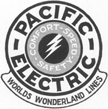Return to ERHA homepage
W Pacific Electric
Four Tracks North
Pacific Electric
Four Tracks North
Introduction:
W
FOUR TRACKS NORTH
The arresting spectacle of a four-track interurban system(as distinguished from a four-track electrified steam railway) is perhaps the ultimate development of the age of interurban. The advantage of the four-track system is readily apparent: the local cars and freight trains use one pair of tracks(invariable the outside tracks), leaving the two remaining tracks for the use of high speed passenger trains making few stops. Pacific Electric enjoyed two four-track systems(Ninth & Hooper-Watts on the Southern District and Indian Village-El Molino on the Northern District) and came within an ace of having a third: Vineyard to Venice on the Western District.
PE's total mileage of four-track system was 11.36; 5.99 miles were on the South, and 5.37 were on the North. To the best of the editor's knowledge, no other interurban company anywhere approached these impressive totals.
The question may well be asked: Why did not the four-track system on the North come further in than Indian Village? The answer has to be topography. Between Valley Junction. and Indian Village there were numerous cuts and fills, plus a viaduct crossing Southern Pacific's main line east. PE never could see its way clear to to spend the large sums necessary to four-track this gap. It felt that by judicious scheduling, the cramping effect of the double track system between these points(1.36 miles) could be largely minimized.
Between a point just east of Macy St. Bridge and Enchandia Junction.(a half mile) there was also a four-track system, but this was operated as a double track system for local cars and freight trains, plus a second two-track system for interurban cars. In effect this worked out to be little better than a long passing track which, much of the time, was blocked by standing freights.
The two outer tracks, comprising a four-track system between Indian Village and El Molino, were constructed by the Los Angeles Interurban Company(a PE affiliate) in 1910 and were placed in operation on October 28th of that year.
Two noteworthy improvements took place down the years: the massive concrete viaduct over Mission Road at Huntington Drive which was constructed in 1934, and the rebuilding and lowering of the four-tracks through El Sereno from approximately Eastern Ave. to Van Horne Ave. in 1928; this featured steel catenary supporting bridges obtained from the Visalia Electric Railway, another SP property.
This exemplary four-track system was ripped up after abandonment of passenger service on the Northern District. Today a portion has been utilized for highways, but the major part is a weed-grown eyesore.
Return to ERHA homepage
